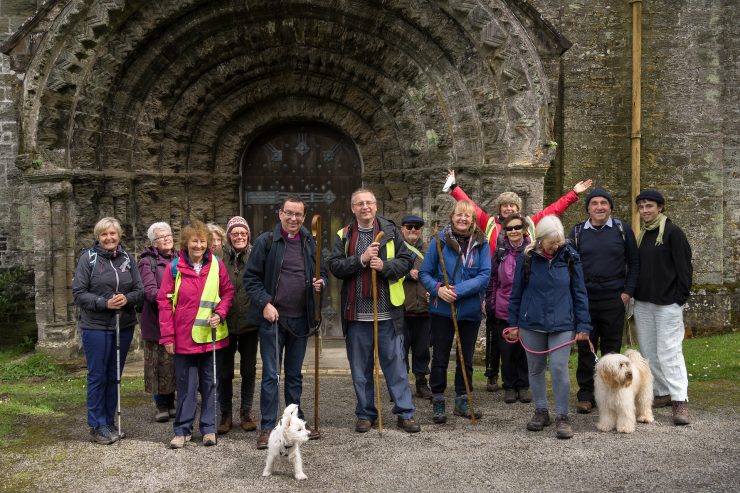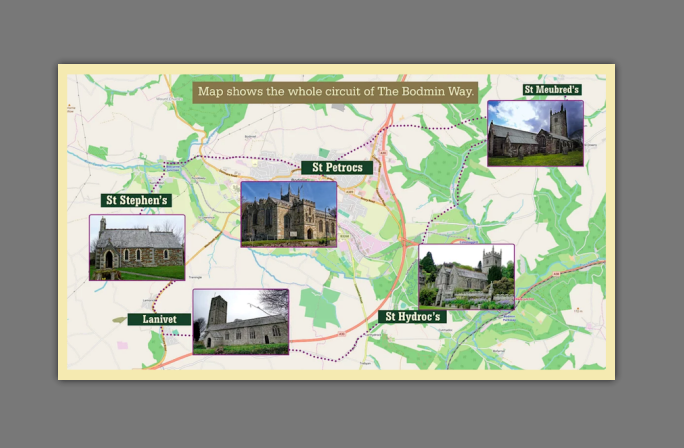Pilgrimages

There are many pilgrim routes across Cornwall, with the most current and high profile one being the Cornish Celtic Way (from St Germans to St Michael’s Mount).
Recently undertaken by the Bishop of St Germans, the Rt Revd Chris Goldsmith, the route is 125 miles, incorporating over 60 miles of our beautiful coastline and takes in two ancient pilgrimage routes – St Michael’s Way (Lelant to Marazion) and the Saints Way (Padstow to Fowey).
Why not enjoy all Cornwall has to offer this summer by taking a walk or joining in with one of the pilgrimages organised by the Diocese of Truro? A great resource for people looking at Pilgrimages in our Diocese and further afield is the British Pilgrimage Trust.
Cornish Celtic Way
It might be 125 miles long, but you don’t have to do it all in one stretch! If you hop across to their website, the Cornish Celtic Way, you’ll find plenty of ideas of how to approach it, which segment could suit you best, how to get there, what you can expect to see and how long a particular walk should take.
Devised by the Revd Nigel Marns, based in Ludgvan, the Cornish Celtic Way is a wonderful route, meticulously researched, that can guide you through a spiritual journey of Cornwall. Not just churches, although there are many beautiful ones all along the route, but holy wells, standing stones, meeting places and simple pathways that have been walked and prayed over for centuries. As Revd Marns says, “The aim of the Cornish Celtic Way is to help anyone, of any age, who is interested in spirituality to explore and develop their faith in a different way. Having faith isn’t about just going to a place of worship, it’s about getting out and experiencing it in everyday life as well, taking it into your own hands.”
To find out more about the Cornish Celtic Way, why we think pilgrimages are in the zeitgeist and how Bishop Chris got on, have a look here.
The full route (as walked by Bishop Chris)
Day one: St Germans to Downderry (via Sheviock) – 12km/ 7.5 miles
Day two: Downderry to Schlerder Abbey (via Looe, Talland) – 19km/ 11.9 miles
Day three: Schlerder Abbey to Polkerris (via Lanteglos, Polruan, Fowey) – 12km/ 7.5 miles
Day four: Polkerris to Luxulyan (via Tywardreath, St Blazey) – 12km/ 7.5 miles
Day five: Luxulyan to Withiel (via Lanivet) – 15km/ 9.4 miles
Day six: Withiel to Little Petherick (via St Issey) – 12km/ 7.5 miles
Day seven: Little Petherick to St Eval (via Padstown, Trevone, St Merryn) – 14km/ 8.1 miles
Day ten: St Eval to St Columb Minor (via St Mawgan) – 13km/ 8.1 miles
Day eleven: St Columb Minor to Cubert (via Newquay, Crantock) – 12km/ 7.5 miles
Day twelve: Cubert to Perranporth (via Oratory) – 11km/ 6.9 miles
Day thirteen: Perranporth to Portreath (via St Agnes) – 16km/ 10 miles
Day fourteen: Portreath to Lelant (via Gwithian, Phillack, St Elwyn) – 19km/ 11.9 miles
Day fifteen: Lelant to St Michael’s Mount (via St Ives, Ludgvan, Marazion) – 20km/ 12.5 miles
Download the route Information about the churches
St Michael’s Way
St Michael’s Way is 12.5 miles long and stretches between Lelant near St Ives to St Michael’s Mount in Marazion. The route is the only footpath in Britain that is designated a European Cultural Route as it is part of a network of pilgrim routes which lead to St James’ Cathedral in Santiago de Compostela in Spain, one of the three most important sites of Christian Pilgrimage in the World.
Bishop Chris, our intrepid pilgrim, walked St Michael’s Way to raise money for Christian Aid.
The Saints’ Way
The Saints’ Way crosses mid-Cornwall from coast to coast covering approximately 30 miles from Padstow to Fowey. It’s the ancient route used by Celtic and medieval pilgrims to cross Cornwall on their way to Santiago de Compostella in Northern Spain. Dotted with rolling pastures of ancient farmland, pre-historic remains, ancient bridges and pathways, you can expect to see some of the most beautiful scenery in the county. It’s a route that has welcomed pilgrims to its pretty riverside villages for centuries.
We have issued a Saints’ Way passport that you can get stamped along the route, just like on the great Camino. To pick up your passport, call into any of the 12 churches along the route, listed below, or download a copy here.
Churches along the Saints’ Way
St Petroc Church, Padstow; Lanivet Church, Lanivet; St Cyrus & St Julietta Church, Luxulyan; St Petroc Minor Church, Little Petherick; St Brevita Church, Lanlivery; St Blaise Church, St Blazey; St Issey Church, St Issey; St Bartholomew Church, Lostwithiel; St Andrew Church, Tywardreath; St Clement Church, Withiel; St Sampson Church, Golant; St Fimbarrus Church, Fowey.
If you don’t feel like walking the full length of the trail there is a shorter alternative route which passes through the Tywardreath site of a medieval monastic settlement. This route is approximately 11 miles long.
The Bodmin Way
This is the newest of the pilgrimage routes in the diocese, connecting five churches around Bodmin, following ancient pilgrim pathways. Linking into the Saints’ Way and the Cornish Celtic Way, it promises a trail of pilgrimage, history, heritage, art and health.
A 20-mile circuit, it could be walked in a day, taking rest breaks in each of the churches. Alternatively, you could take a more leisurely pace over two days, walking on the first day from Cardinham to Bodmin, Nanstallon to Lanivet where you could stay for the night. On the second you could complete the circuit by going on to Lanhydrock before walking back to Cardinham. Or you could just walk between locations in your own time, at your own pace and enjoy the wonder of it all. As they say…
Whether …
You are local or a tourist,
You are alone or with family and friends,
You see a spiritual dimension to pilgrimage or the health benefits only,
You are interested in heritage or enjoy the great outdoors,
You are a walker, cyclist, driver or passenger …
The Bodmin Way is for you!

For further information click on the links
The Bodmin Way
Facebook
Or find them on Instagram by searching bodminway.
For any other queries email the team at: info@bodminway.org
